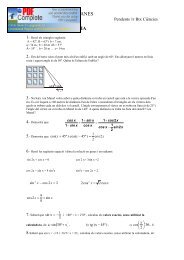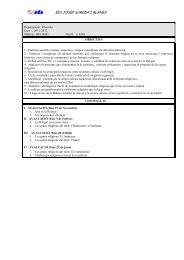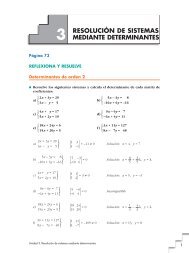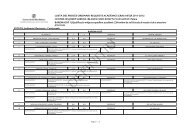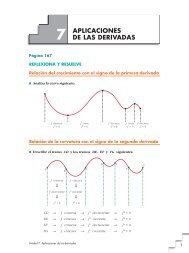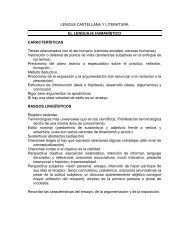Tema 6: Derivadas. Técnicas de derivación
Tema 6: Derivadas. Técnicas de derivación
Tema 6: Derivadas. Técnicas de derivación
You also want an ePaper? Increase the reach of your titles
YUMPU automatically turns print PDFs into web optimized ePapers that Google loves.
°§¢§£°¢£°¢£UNIDAD6límx 8 0f(x)lím (ax + b) = bx 8 0 –lím (x 2 – 3x + 2) = 2x 8 0 +Para que lím f(x) = f(0) = 2, <strong>de</strong>be ser b = 2.x 8 0Si b = 2, f es continua en Á.f'(x) =° a si x < 0¢£ 2x – 3 si x > 0Veamos si f es <strong>de</strong>rivable en x = 0:f'(0 – ) = af'(0 + ) = –3Para que exista f'(0), <strong>de</strong>be ser a = –3.YSi a = –3, f es <strong>de</strong>rivable en Á.f(x) =£°¢° –3x + 2 si x < 0¢£ x 2 – 3x + 2 si x Ó 011X5. ¿En qué puntos no es <strong>de</strong>rivable la función f(x) = |x 2 – 4x + 3|? Justifica turespuesta.Definimos la función por intervalos. Para ello, hacemos:x 2 – 4x + 3 = 0 8 x =4 ± √16 – 122x = 1x = 3° x 2 – 4x + 3 si x Ì 1§f(x) = ¢ –x 2 + 4x – 3 si 1 < x < 3§£ x 2 – 4x + 3 si x Ó 3Hallamos f'(x):° 2x – 4 si x < 1§f'(x) = ¢ –2x + 4 si 1 < x < 3§£ 2x – 4 si x > 3Estudiamos la <strong>de</strong>rivabilidad <strong>de</strong> f en x = 1 y en x = 3:f'(1 – ) = 2 · 1 – 4 = –2f'(1 + ) = –2 · 1 + 4 = 2Como f'(1 – ) ? f'(1 + ), no existe f'(1).f'(3 – ) = –2 · 3 + 4 = –2f'(3 + ) = 2 · 3 – 4 = 2Como f'(3 – ) ? f'(3 + ), no existe f'(3).f no es <strong>de</strong>rivable ni en x = 1, ni en x = 3.Unidad 6. <strong>Derivadas</strong>. <strong>Técnicas</strong> <strong>de</strong> <strong>de</strong>rivación37



